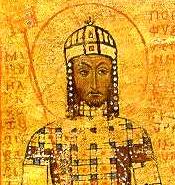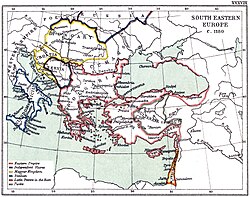Battle of Myriokephalon
Immediately after peace was negotiated the Seljuk sultan Kilij Arslan II visited Constantinople where he was treated by Emperor Manuel I Komnenos as both an honoured guest and an imperial vassal.
When the strongest Muslim ruler in Syria Nur ad-Din Zangi died in 1174, his successor Saladin was more concerned with Egypt and Palestine than the territory bordering the Empire.
This shift in power gave Kilij Arslan the freedom to destroy the Danishmend emirates of eastern Anatolia and also eject his brother Shahinshah from his lands near Ankara.
In 1175 the peace between Byzantium and the Sultanate of Rûm fell apart when Kilij Arslan refused to hand over to the Byzantines, as he was obliged to do by treaty, a considerable proportion of the territory he had recently conquered from the Danishmends.
[9] The army gathered at Lopadion by Manuel was supposedly so large that it spread across ten miles, and marched towards the border with the Seljuks via Laodicea, Chonae, Lampe, Celaenae, Choma and Antioch.
Arslan harassed the Byzantine army in order to force it into the Meander valley, and specifically the mountain pass of Tzivritze near the fortress of Myriokephalon.
Once at the pass Manuel decided to attack, despite the danger from further ambushes, and also despite the fact that he could have attempted to bring the Turks out of their positions to fight them on the nearby plain of Philomelion, the site of an earlier victory won by his grandfather Alexios.
The lack of forage, and water for his troops, and the fact that dysentery had broken out in his army may have induced Manuel to decide to force the pass regardless of the danger of ambush.
[3] Birkenmeier believes that the army contained 25,000 Byzantine troops with the remainder composed of an allied contingent of Hungarians sent by Manuel's kinsman Béla III of Hungary and tributary forces supplied by the Principality of Antioch and Serbia.
These troops formed the core of field armies and were medium to heavy cavalry; they were armoured, and fought in coherent units with bow and lance.
[25] The emperor was eventually roused by his officers, re-established discipline and organised his forces into a defensive formation; when formed up, they pushed their way past the wreck of the baggage and out of the pass.
[25] Niketas Choniates states that Manuel considered abandoning his troops but was shamed into staying by the scathing words of an anonymous soldier and the disapproval of a shocked Kontostephanos.
The following day, the Turks circled the camp firing arrows; Manuel ordered two counterattacks, led by John Angelos and Constantine Makrodoukas respectively, but there was no renewal of a general action.
[4][5] As the Byzantine army moved back through the pass after the battle it was seen that the dead had been scalped and their genitals mutilated, "It was said that the Turks took these measures so that the circumcised could not be distinguished from the uncircumcised and the victory therefore disputed and contested since many had fallen on both sides.
Also the Seljuk Sultan was keen for peace to be restored as soon as possible; he sent an envoy named Gabras, together with gifts of a Nisaean warhorse and a sword, to Manuel in order to negotiate a truce.
[30] As a result of these negotiations, the Byzantine army was to be allowed to retreat unmolested on condition that Manuel destroy his forts and evacuate the garrisons at Dorylaeum and Sublaeum in the Byzantine-Seljuk borderlands.
However, in the same message he: "Then extolled the treaties made with the sultan, boasting that these had been concluded beneath his own banner which had waved in the wind in view of the enemy's front line so that trembling and fear fell upon them.
A possible reason for Kilij Arslan's reluctance to renew the battle is that a large proportion of his irregular troops may have been far more interested in securing the plunder they had taken than in continuing the fight, thus leaving his army seriously weakened.
Ironically, this battle was a reverse of Myriokephalon, with a Seljuk army blundering into a classic ambush laid by the Byzantine general John Komnenos Vatatzes.
[35] However, like Manzikert, Myriokephalon was a pivotal event and following it the balance between the two powers in Anatolia gradually began to shift, and subsequently, Byzantium was unable to compete for dominance of the Anatolian interior.
However, it has been argued that Manuel's preoccupation with exerting influence over the Latins of Europe and the Crusader states of the Levant was aimed at ensuring Byzantine security in the Balkans and Anatolia.
[37] The period of peace with Byzantium had given the Sultan many years in which to eliminate his rivals, enabling him to build up a force capable of facing the Byzantine army in the field.

